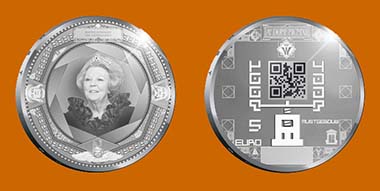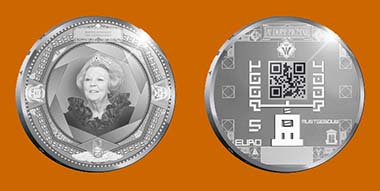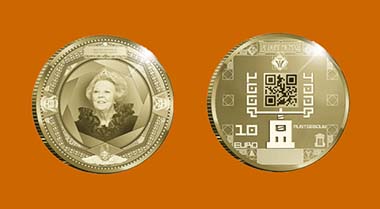June 30, 2011 – In 2011 the Netherlands celebrates the 100th anniversary of the Mint building in Utrecht. To honor the centennial the Dutch Ministry of Finance authorized the issue of an additional commemorative coin this year.
A special feature on this coin is a 2D (two dimensional) QR bar code. This graphic image stores information both horizontally – as one-dimensional bar codes do, and vertically. QR bar codes are often used in conjunction with smart phones where the user simply photographs the bar code with the camera on a phone equipped with a bar code reader. This function enables the user to see relevant websites on his phone. Such bar codes are now gaining increasing use in trade and commerce, being used for such things as airplane boarding passes and targeted advertising. In this case, scanning the bar code on the coin directs the user to a website devoted to more information about the coin and the building it celebrates.
The coin was designed by an engraver at the Dutch Mint, Juan José Sánches Castaño. He makes a point of contrasting the old and the new as a central theme of his presentation, with the bar code positioned within a representation of an old screw press that sits in the lobby of the mint. The obverse bears a traditional presentation of Queen Beatrix. The first strike was scheduled for June 22, with deliveries commencing by the middle of July. The gold and silver versions have very low mintages of just 3,500 and 12,500 coins, respectively. The gold 10 euro proof coin comes in a wooden box with numbered certificate of authenticity. It is identical to the old Dutch 10 guilder coin (.900 fine gold, 6.72 grams, 22.5 mm). The .925 (sterling) silver, 15.5 gram, 5 euro proof coin comes in a pop-up display package. Also being issued are 250,000 silver-plated 5 euro copper-nickel coins, also 33 mm in diameter, these weigh 10.5 grams.
One report on the new feature of the “QR” bar code may be seen here.
More information on this coin you can find here.





